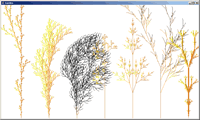
 Plant
Architecture: Bracketed L-Systems. A fascinating
algorithm for rendering images of plants involves perpetuating a string of
coded characters that are, in turn, interpeted by a drawing pen or turtle.
Two dimensional examples created by the class of 2006-7 appear at the right.
Here's a 3D example. The orginal idea is credited to Astrid
Lindenmayer, who proposed, in 1968,
"an axiomatic theory of development" for plant structure. Hence the
name L-Systems.
Plant
Architecture: Bracketed L-Systems. A fascinating
algorithm for rendering images of plants involves perpetuating a string of
coded characters that are, in turn, interpeted by a drawing pen or turtle.
Two dimensional examples created by the class of 2006-7 appear at the right.
Here's a 3D example. The orginal idea is credited to Astrid
Lindenmayer, who proposed, in 1968,
"an axiomatic theory of development" for plant structure. Hence the
name L-Systems.
In this in-class exercise, you are asked to supply the code necessary to reproduce
the images described on Page
25, using the driver Garden.java.
Add the missing
code to produce the graphic at the top right.
Reverse Polish Notation. In this assignment, you are to evaluate a
simple arithmetic expression, supplied in postfix notation (also called Reverse
Polish Notation).
For example, consider the standard infix notation, 2*(3+4). Written as an RPN
expression,
it would appear as 234+*. Develop the class, Expression, that contains the
methods,
public void setRPN(String rpn)
and
public double evaluate()
The ExpressionTest.java driver should return output similar to,

Bracket Matching. Create a project entitled Brackets and download
the file Brackets.java as the driver.
You will also require, ArrayStack.java and Stack.java in
your project. Complete the body of the recursive method,
private static boolean BracketsMatch(String L, int i)
so the output yields,

Algorithm. The approach involves a push of the open
(left) brackets onto a Stack as they are encountered. An occurrence of a close
(right)
brackets
signals
a pop (if possible) the top element from the Stack and a comparison
to confirm it is a match. If it is, keep processing. The task is complete if
the end of the String is encountered and there a no more eements on the Stack.

 Plant
Architecture: Bracketed L-Systems. A fascinating
algorithm for rendering images of plants involves perpetuating a string of
coded characters that are, in turn, interpeted by a drawing pen or turtle.
Two dimensional examples created by the class of 2006-7 appear at the right.
Here's a 3D example. The orginal idea is credited to Astrid
Lindenmayer, who proposed, in 1968,
"an axiomatic theory of development" for plant structure. Hence the
name L-Systems.
Plant
Architecture: Bracketed L-Systems. A fascinating
algorithm for rendering images of plants involves perpetuating a string of
coded characters that are, in turn, interpeted by a drawing pen or turtle.
Two dimensional examples created by the class of 2006-7 appear at the right.
Here's a 3D example. The orginal idea is credited to Astrid
Lindenmayer, who proposed, in 1968,
"an axiomatic theory of development" for plant structure. Hence the
name L-Systems.
